Spring Peach Care: Key Activities in the Peach Garden
Peach is a rather demanding crop, therefore, in order for it to fully develop and give a stable harvest, it needs to be provided with appropriate spring care.
To do this, it is worth adhering to certain rules and recommendations that will help novice gardeners to master the agricultural technology of growing this tree and properly care for a peach in spring.
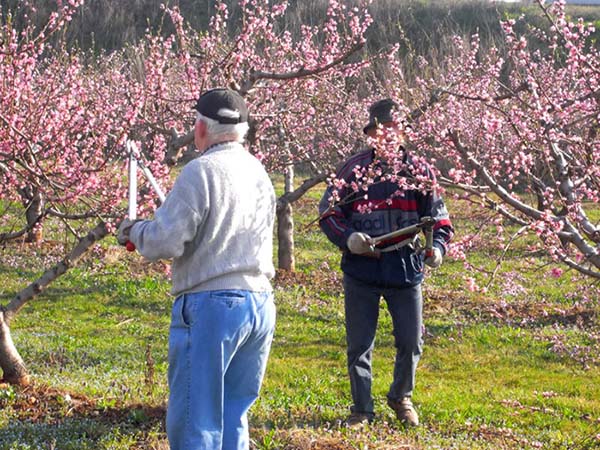
Content
What is included in spring peach care
The main volume of work on peach care falls on the spring period, since after winter the tree especially needs full care. This will help him recover from winter and start an active growing season.
Worth knowing! The main condition for the successful cultivation of peach in regions with a more severe climate is the correct choice of zoned varieties, otherwise the harvest may never be expected.
Pruning
Spring pruning of a tree must be carried out at the beginning of March at a plus air temperature of at least +5 degrees, regardless of the time of day. If the winter was very frosty, then experts recommend postponing this procedure until the beginning of the growing season in order to accurately determine the degree of frostbite of the shoots and the level of pruning. The more damaged the peach is, the less it costs to prune it so as not to weaken the tree's immunity.
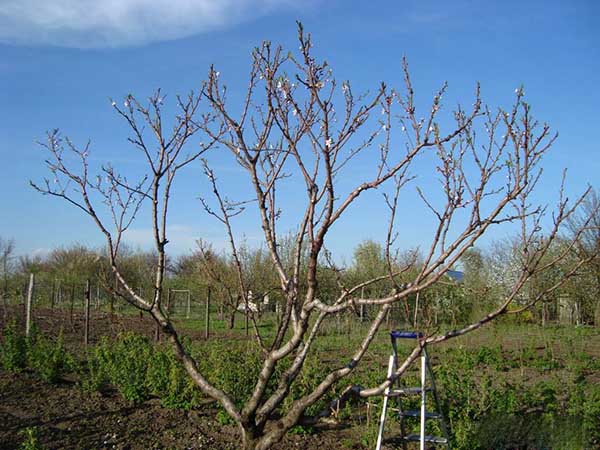
The annual procedure helps to form the crown of young seedlings and rejuvenate old trees. Pruning helps to redistribute nutrients, maintain a balance between crown and root system, and also significantly accelerates the fruiting process and creates convenience in harvesting.
In addition, the crown is cleaned from branches thickening it, dry and damaged shoots.
Important! For more information on this type of peach care in spring as pruning, readin this article.
Video: A detailed overview of spring peach pruning
Graft
It is necessary to vaccinate the peach in mid-March - early April, so that return frosts do not lead to the rejection of the scion. The optimal type of rootstock is the peach itself, plum, apricot and cherry plum, but in the latter case, due to the formation of a large amount of root growth, its constant removal will be required in order to correctly redistribute the strength of the tree.
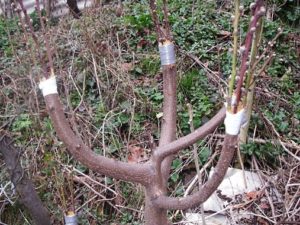
Worth knowing! It is not recommended to plant a peach after spraying the crown against pests and fungal diseases.
The choice of the method of vaccination must be weighed against the experience of the gardener, since training and experience are necessary for its successful implementation. The most common types of vaccinations are:
- copulation;
- into cleavage;
- budding;
- in the side cut;
- for the bark.
By the way! You can find all information about this manipulation here.
Protective treatment against diseases and pests
An obligatory part of spring peach care is its treatment against diseases and pests, since experienced gardeners know that without it, you can not even dream of any harvest. The most dangerous enemies of this culture are:
- curly leaves;
- moniliosis;
- clasterosporium disease;
- powdery mildew;
- scab;
- aphid;
- weevil flower beetle;
- ticks;
- fruit moth.
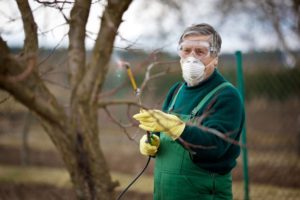
In order for the peach to develop normally and bear fruit, it is necessary to provide 4 stages of comprehensive protection, each of which is carried out in a certain period of time:
- Stage 1 (whitewashing of trunks) - at the end of February-at the beginning of March;
- Stage 2 (spraying the crown) - until the buds extend;
- Stage 3 (spraying the crown) - when the buds are extended;
- Stage 4 (spraying the crown) - after flowering.
Spring processing will help protect the tree throughout the season and eliminate the risk of retaining harmful substances in the fruits by the time they ripen. It is possible to spray against pests and diseases at the same time, which will reduce the number of necessary procedures, but at the same time it is worth observing the tank compatibility of the preparations.
Advice! Detailed information about the procedure peach processing during spring care behind the culture you can find by this link.
Transfer
If there is a need to transplant a peach tree, you should take into account some of the features of its implementation. Peach prefers to grow in open sunny areas and does not tolerate even light shading. Therefore, a new place should be selected based on the needs of the culture.
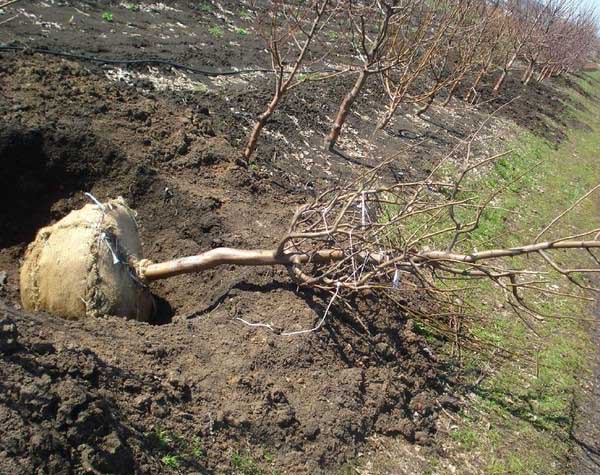
Peach transplant should be done before the beginning of the growing season, that is, from mid-March to early April. This guarantees a quick adaptation of the tree to a new place and a timely start of the growing season. The increased soil moisture in the spring guarantees a high level of survival, and therefore the crop reacts minimally to the stress received.
Worth knowing! Peach seedlings can be transplanted no older than 3 years of age.
In order for the seedling to take root in a new place faster and grow, it is necessary to water it during transplanting with a working solution of "Kornevin" (5 g per 5 liters of water). And shorten the side shoots on the trunk by 1/3 of the entire length in order to restore the balance between the crown and the root system.
By the way! To read the article on planting a peach in spring - Click here.
Top dressing
In order for a peach to actively grow, bloom and bear fruit, it is necessary to regularly feed the tree. During the spring peach care, this procedure is most relevant, since the roots during this period are very susceptible and fully absorb the fertilization.
Feeding young peach seedlings should be started from the second year after planting in a permanent place. Early spring (first stage of feeding) preference must be given nitrogen fertilizers, which stimulates the growth processes of the tree. During this period, you can use urea (carbamide) at the rate of 120 g per square meter of the trunk circle. Fertilizer should be scattered at the base of the tree and covered with damp earth. Also suitable for this feeding phase calcium or ammonium nitrate at the rate of 60 g per 1 sq. meter.
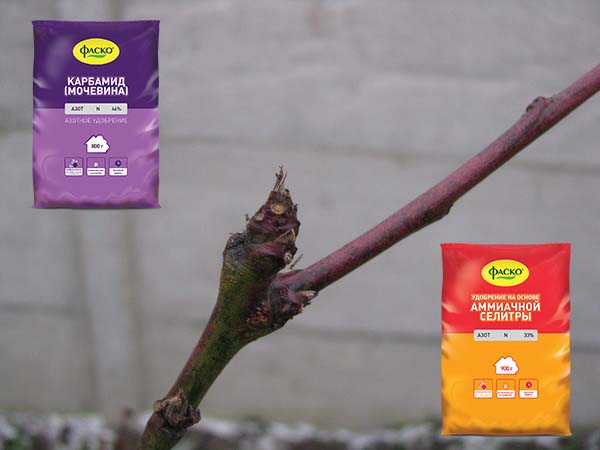
Worth knowing! Root feeding of peaches must be carried out on moist soil, therefore, in the absence of seasonal rains, the tree should be watered abundantly beforehand.
Second phase feeding the peach tree must be carried out in period of extension of peduncles. At this time it is worth makingpotassium chloride (40 g), ammonium nitrate (50 g) and superphosphate (100 g). For correct application, a groove should be made around the perimeter of the tree crown, into which fertilizer should be applied, and then the depression should be covered with soil.
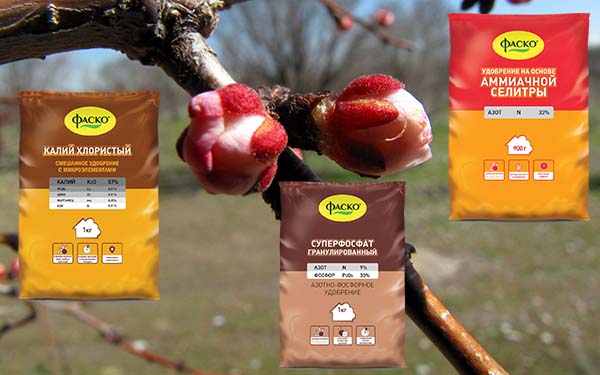
Stage three peach feeding should be done directly after floweringto restore the strength of the tree. During this period are used similar fertilizers as in the second stage... From 5 years of age, the amount of fertilizer applied should be increase by 1/3.
Worth knowing! The quality of the future harvest directly depends on the spring feeding of the crop.
Video: how and what to properly fertilize and feed fruit trees
Watering, loosening and mulching
The peach is considered a drought-resistant crop and therefore can easily tolerate a lack of moisture in the soil, but there are certain periods when the tree is especially in need of water. During the beginning of the growing season, a lack of water can cause the development of weak leaf plates, which will negatively affect the process of photosynthesis in them. And also this problem can lead to the fact that not all kidneys wake up after winter.
Adequate soil moisture is equally important during flowering and fruit ovary, since during this period the load on the tree increases.
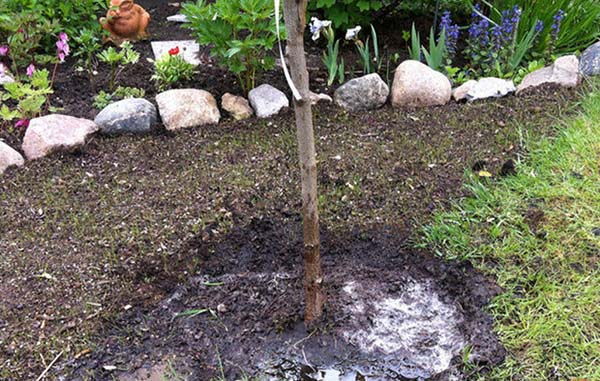
Recommended watering rates for peaches in spring:
- a tree up to two years old - 15 liters of water for each square meter of the trunk circle;
- over three years old - 20 liters of water for each square meter at the base.
It is equally important to loosen the soil in the peach trunk circle in the spring. This procedure reduces the risk of developing fungal diseases in the soil in conditions of high humidity, and also guarantees air access to the roots in full. It is necessary to loosen the soil after every rain or watering of the peach tree.
In order not to dry out the soil at the base of the tree, and also in order to reduce watering, the peach trunk circle should be covered with mulch (mulch). Experts recommend using straw or peat for this, pouring a layer of 3-4 cm. Mulch should be placed not close to the trunk, as it can cause the bark to undergo, and this will significantly weaken the peach's immunity.
Peach care features in different regions
When growing and caring for peaches in the Middle Strip (Moscow region) during the flowering of the culture, it is necessary to worry about additional shelter of the crown, since there is a possibility of frost return, which will destroy most of the peduncles.Therefore, it is better to cover the tree with a spunbond, in which to make holes for pollinating insects.
In the Volga region peach can be grown only if zoned varieties are selected, since no care can protect the culture from cold winds. And also in the spring it is necessary to pay special attention to watering, since in the conditions of this region, early drought is possible.
In the conditions of Siberia and the Urals when feeding peaches in spring, nitrogen fertilizers can be used only at the first stage of the procedure. A later introduction leads to the fact that the shoots do not have time to ripen before winter, which will significantly weaken the tree's immunity in winter.
Common mistakes of spring peach care
Sometimes even experienced gardeners make mistakes during spring care, which can negatively affect the growth, development and fruiting of a peach. To avoid them, you should familiarize yourself with them in advance, which will help achieve the desired result:
- In the absence of tree pruning and cleaning the crown from thickening branches, the fruits become small and their taste decreases.
- If young shoots regularly freeze out in winter, which affects the amount of the crop, then the problem lies in the late application of nitrogen fertilizers, which does not allow the branches to prepare for winter.
- A sharp drop of flowers and ovary is an indicator of a lack of moisture in the soil, since the tree is not able to withstand the load.
- Excessive application of mineral fertilizers leads to an increase in the level of salts in the soil, which over time begins to suppress the root system of the tree.
- The complete freezing of a young seedling is a sign of the wrong choice of a variety for a given region.
Peach is a tree that does not tolerate neglect. It will grow and bear fruit regularly only if it is properly cared for in spring, summer and autumn. Otherwise, you should not count on a high-quality harvest.

